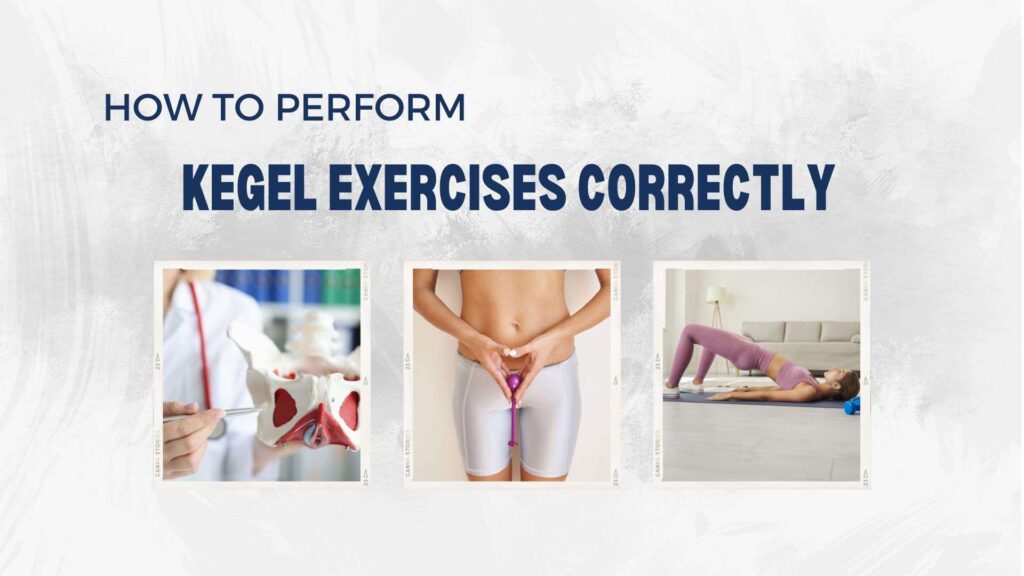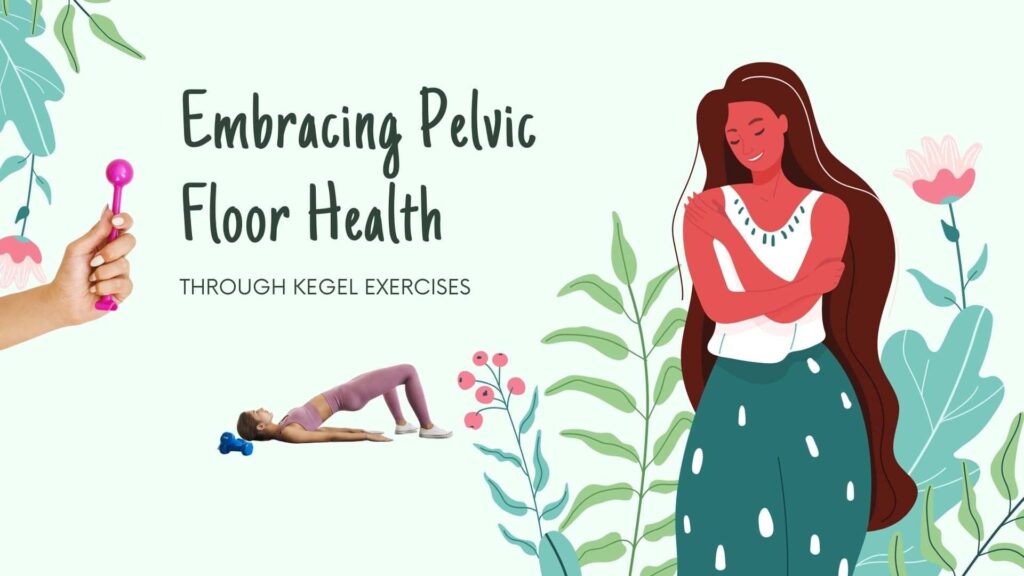The Ultimate Guide to Kegel Exercises: Benefits, Techniques, and Common Mistakes
Imagine having the power to improve your health, increase your confidence, and enhance intimacy in your life —all through a simple exercise. Kegel exercises.. it’s much more than just fitness. Whether you are new to the idea or looking to improve your technique, or you are a new mom looking to regain strength after childbirth, Also, if you are a man dealing with prostate issues, this guide helps you understand the surprising array of benefits to master proper technique and avoiding common pitfalls. You will discover why these simple squeezes deserve a prime spot in your daily routine.
But, despite their potential benefits for both men and women, Kegel exercises remain a mystery and misconception for many. Let’s learn about Kegel exercises and their benefits and discover how these simple yet powerful exercises can transform your health from the inside out.
Key takeaways
As you embark on your Kegel journey, keep these key points in mind:
- Start by correctly identifying your pelvic floor muscles.
- Avoid common mistakes like using incorrect muscles or forgetting to relax.
- Be patient and consistent – results typically appear after 12 weeks of regular practice.
- Both men and women can benefit from regular Kegel exercises.
- Factors like pregnancy, aging, and certain health conditions can cause pelvic floor weakness.
- Biofeedback training can enhance the effectiveness of Kegel exercises
- Don’t hesitate to seek professional help from a pelvic floor physiotherapist if you are unsure or experiencing difficulties.

What are Kegel exercises?
Kegel exercises, named after American gynecologist Arnold Kegel who first described them in 1948. These discreet muscle contractions have been quietly revolutionizing pelvic floor health for decades. They are specialized movements that involve repeatedly contracting and relaxing the pelvic floor muscles and are designed to strengthen them. These muscles form a hammock-like structure that supports crucial organs like the bladder, uterus (in women), and rectum. Think of your pelvic floor as the foundation of a house – when it’s strong, everything above it stays in place and functions properly.
But why should you care about these hidden muscles? Well, it plays a vital role in
- Improving bladder control and reducing urinary incontinence
- Prevent or control bowel incontinence
- Improve sexual function and satisfaction
- Support pelvic organs, prevent and treat pelvic organ prolapse
- Aid in recovery after childbirth or prostate surgery

The benefits of Kegel exercises
It offers numerous benefits for both women and men, though the specific advantages can differ between the sexes due to anatomical differences. Let’s explore the benefits for each gender individually.
Benefits of kegel exercises in women
Improved bladder control
One of the primary benefits of Kegel exercises is their ability to reduce or eliminate urinary incontinence in women. Studies have shown that regular Kegel practice can significantly reduce symptoms of stress urinary incontinence. In fact, success rates for reducing stress urinary incontinence with these exercises range from 27% to 75%.
Enhanced sexual function
A strong pelvic floor muscle can lead to improved sexual experiences in women. They can increase vaginal sensation during intercourse, lubrication, enhanced arousal and the intensity of orgasms. While more research is needed, many individuals report increased sexual satisfaction after incorporating Kegels into their routine.
Support for pelvic organs
As we age, our pelvic floor muscles can weaken, potentially leading to pelvic organ prolapse. This condition occurs when pelvic organs drop from their normal position. Regular strengthening of the pelvic floor can help prevent or manage mild cases of prolapse and improve the strength of supportive muscles.
Pregnancy and postpartum recovery
Kegels can prepare the pelvic floor for childbirth, potentially making delivery easier. After childbirth, these exercises can help restore pelvic floor strength and function, aid in faster recovery and help prevent postpartum urinary leakage.
Fecal incontinence prevention
By strengthening the muscles around the anus, Kegels can help prevent accidental bowel leakages.
Benefits of Kegel exercises in men
Improved bladder control
Regular Kegel exercises can help men regain bladder control, reduce overactive bladder, and manage and prevent urine leakage, a common issue as men age or after prostate surgery. Stronger pelvic floor muscles provide better support to the bladder, reducing the risk of leaks and improving urine control.
Erectile function and enhanced sexual health:
Regular pelvic floor exercises may improve erectile function and increase the strength of erections in men by enhancing blood flow to the genital area. Additionally, they may help with premature ejaculation, allowing men to have better control over ejaculation and potentially improving sexual satisfaction.
Prostate health support
For men with chronic prostate issues, including benign prostatic hyperplasia (BPH) or those recovering from prostate surgery, Kegel exercises can aid in recovery and improve overall prostate health by reducing symptoms like urinary urgency and frequency.
Post-surgery recovery
After surgeries such as prostatectomy, Kegel exercises are often recommended to help men regain bladder control and strengthen the pelvic floor muscles that may have weakened during the procedure.
Bowel control
As with women, Kegels can help men improve control over bowel movements and prevent fecal incontinence.
Core stability and overall strength
The pelvic floor is part of the body’s core muscle group. Strengthening it through Kegels can contribute to better core stability, improved posture, and a stronger overall physique.

How to perform Kegel exercises correctly
Now that we understand the importance of Kegels, let’s learn how to do them appropriately. Remember, quality trumps quantity when it comes to these exercises. Performing Kegel exercises correctly is essential to maximizing their benefits.
Step 1: Identify the right muscles
The first and most crucial step is to locate your pelvic floor muscles.
Important: Don’t make a habit of stopping your urine stream regularly, as this can lead to incomplete bladder emptying and increase the risk of urinary tract infections.
Once you’ve identified these muscles, you can perform Kegel exercises anywhere—no need to interrupt your bathroom routine!
Step 2: Perfect your technique
Once you’ve identified the correct muscles, follow these steps:
Step 3: Incorporate different types of Kegels
There are two main types of Kegel exercises, each targeting different muscle fibers:
- Slow Kegels: These target slow-twitch muscle fibers responsible for prolonged bladder and bowel control.
- Fast Kegels: These work fast-twitch muscle fibers that respond quickly to sudden pressure, like during a cough or sneeze.

Tips for successfully doing kegels

Common mistakes to avoid in kegels
Even with the best intentions, it’s easy to make mistakes when performing Kegel exercises. Here are some common pitfalls and how to avoid them:
1. Avoid using incorrect muscles
Many people inadvertently contract their abdominal, buttock, or inner thigh muscles instead of their pelvic floor. This not only makes the exercises ineffective but can also lead to muscle imbalances. Focus on isolating your pelvic floor muscles. If you’re unsure, consider using biofeedback tools or consulting a pelvic floor physiotherapist.
2. Focus on technique
Quality over quantity. Ensure you’re performing the exercises correctly rather than rushing through them.
3. Avoid overexerting the muscles
While it might seem logical that more is better, overdoing Kegel exercises can lead to muscle fatigue and potentially worsen symptoms. Stick to the recommended sets and repetitions. Quality is more important than quantity.
3. Don’t forget to relax
Relaxation is just as important as contraction in Kegel exercises. Constantly tensing the pelvic floor muscles without proper relaxation can lead to pelvic floor dysfunction. Ensure you’re fully relaxing your muscles between contractions. Practice “reverse Kegels” or dropping exercises to improve your relaxation technique.
4. Avoid holding your breath
Many people unconsciously hold their breath while performing Kegels, which can increase abdominal pressure and strain the pelvic floor. It is essential to focus on maintaining normal breathing throughout your exercises.
5. Giving up too soon
Consistency is key. Many people give up before seeing results, which typically take at least 12 weeks of regular practice to manifest. Commit to a 12-week program before evaluating your progress. Keep a journal to track improvements in symptoms.
By following these steps, you’ll be on your way to effectively strengthening your pelvic floor muscles and reaping the full benefits.

Kegel exercises for different populations
Kegel exercises offer benefits for various populations, from new mothers to aging adults, each with unique needs. Here’s how these exercises can be tailored to different groups:
Pregnant women
- Preparation for childbirth: Strengthening the pelvic floor during pregnancy can help prepare the body for labor and delivery. It may also reduce the risk of perineal tears during childbirth.
- Support during pregnancy: As the baby grows, the additional weight puts pressure on the pelvic muscles and these exercises can help maintain muscle tone, supporting the bladder and reducing the risk of incontinence.
New mothers
- Postpartum recovery: After childbirth, many women experience weakened pelvic floor muscles, leading to issues like urinary incontinence, and the Kegel exercises help restore strength and support recovery. Women should start with gentle contractions and gradually increase intensity as their bodies heal.
- Ease back into exercise: Kegels provide a low-impact way of exercising for new mothers and ease back into physical activity without straining their bodies. They can be done discreetly while caring for a newborn, making them an ideal first step in postpartum fitness.
Men
Contrary to popular belief, Kegel exercises aren’t just for women. For men, the focus is often on the muscles around the base of the penis and anus. Men can also benefit, particularly in cases of:
- Prostate health: Men dealing with prostate issues or recovering from prostate surgery can benefit greatly from these exercises. Pelvic floor therapy supports recovery, improves bladder control, and enhances sexual function.
- Sexual performance: For men, Kegels can lead to stronger erections and improved control over ejaculation, enhancing sexual health and confidence
Aging adults
- Prevention of incontinence: As we age, the risk of urinary incontinence increases due to the natural weakening of the pelvic floor muscles. Regular Kegel exercises can help maintain strength and control, reducing the likelihood of incontinence.
- Improved quality of life: For older adults, maintaining pelvic floor strength is crucial for independence and confidence. Kegels can be an easy, low-impact way of exercising to preserve these muscles and enhance daily life.
Individuals with pelvic floor disorders
- Pelvic organ prolapse: Kegel exercises can be beneficial for those experiencing pelvic organ prolapse, where pelvic organs slip out of place. Strengthening the pelvic floor may help manage symptoms and prevent further progression.
- Chronic pelvic pain: In some cases, Kegels can be part of a treatment plan for chronic pelvic pain, though it’s essential to consult a healthcare provider to ensure the exercises are appropriate and beneficial for the specific condition.
Athletes
- Core stability: For athletes, a strong pelvic floor contributes to overall core stability, enhancing performance in sports that require balance, strength, and endurance.
- Injury prevention: A well-conditioned pelvic floor can help prevent injuries related to core instability, such as lower back pain or hip issues.
Individuals with disabilities
- Tailored approaches: For individuals with physical disabilities, pelvic floor muscle training can be adapted to fit their specific needs and abilities. A healthcare provider can offer guidance on how to safely and effectively incorporate these exercises into their routine.

When to seek professional help
While Kegel exercises are generally safe and beneficial, there are instances where professional guidance is necessary:
Seeking professional help from a pelvic floor physiotherapist can make all the difference in getting the most out of your Kegel exercises, ensuring that they are done correctly and effectively, and addressing any underlying issues that may require specialized care.

Embracing pelvic floor health
Embracing pelvic floor health through Kegel exercises is a powerful step toward improving your overall well-being, whether you’re aiming to enhance bladder control, boost sexual health, or recover from childbirth or surgery. These simple yet effective exercises offer a way to strengthen one of the most important muscle groups in your body, supporting everything from core stability to daily comfort.
The key to success lies in consistency and proper technique. By incorporating Kegel exercises into your regular routine and seeking professional guidance when needed, you can unlock the full potential of your pelvic floor.
Remember, like any exercise, the benefits grow over time, so be patient and persistent. Your journey to better pelvic health is a lifelong investment and commitment to your body’s strength, resilience, and vitality. So start today and embrace the transformative power of pelvic floor muscle training for a healthier, more confident you.
Beyond Kegels
But while Kegels are a valuable tool, they’re not the whole story. The truth is that maintaining a strong and functional pelvic floor involves more than just one type of exercise. In the next blog, we’ll explore the world beyond Kegels exercise, looking into other exercises, essential practices and lifestyle changes that contribute to a balanced and resilient pelvic floor. Whether you’re seeking to prevent issues or enhance your existing routine, it’s time to broaden your approach and discover what it really takes to achieve optimal pelvic health beyond Kegels.

Cynthia Pathipati – Registered Physiotherapist
Cynthia Pathipati completed her bachelor’s in physiotherapy and is a qualified Registered Physiotherapist in good standing with the College of Physiotherapists of BC with more than 15 yrs of experience. She has Post-Graduate Credentials and Certifications as well as extensive knowledge experience in treating pelvic floor, orthopedic, neurological, vestibular and pain conditions.







